2015 Latest 70-432 Practice Tests Updated By Braindump2go in Accordance with Microsoft Official Exam Center (171-180)
Quick and Effective Microsoft 70-432 Exam Preparation Options – Braindump2go new released 70-432 Exam Dumps Questions! Microsoft Official 70-432 relevant practice tests are available for Instant downloading at Braindump2go! PDF and VCE Formates, easy to use and install! 100% Success Achievement Guaranteed!
Vendor: Microsoft
Exam Code: 70-432
Exam Name: TS: Microsoft SQL Server 2008, Implementation and Maintenance
Keywords: 70-432 Exam Dumps,70-432 Practice Tests,70-432 Practice Exams,70-432 Exam Questions,70-432 PDF,70-432 VCE Free,70-432 Book,70-432 E-Book,70-432 Study Guide,70-432 Braindump,70-432 Prep Guide

QUESTION 171
Drag and Drop Question
You administer a Microsoft SQL Server 2008 R2 database instance that supports a sales management application.
Occasionally, users of the application report that they receive a deadlock error.
You plan to troubleshoot this error.
You need to ensure that the instance is configured to capture troubleshooting information that will allow you to isolate the cause of the error.
Which two actions should you perform in sequence? (To answer, move the appropriate actions from the list of actions to the answer area and arrange them in the correct order.)

Answer:
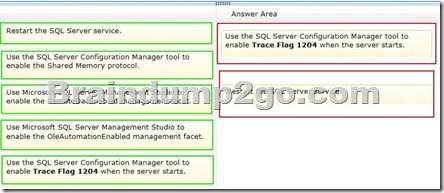
QUESTION 172
Drag and Drop Question
You administer a Microsoft SQL Server 2008 R2 database that contains customer invoice accounts.
Backups are performed according to the following schedule:
– Full database backup at 00:00 hours daily.
– Transaction log backups at 06:00 hours, 14:00 hours, and 20:00 hours daily.
You discover that the database failed at 11:59 hours.
You also discover that the database is no longer accessible due to a failure of the hard disk drive that contains the database data file.
You need to restore the database.
You also need to ensure that data loss is minimal.
Which four actions should you perform in sequence? (To answer, move the appropriate actions from the list of actions to the answer area and arrange them in the correct order.)
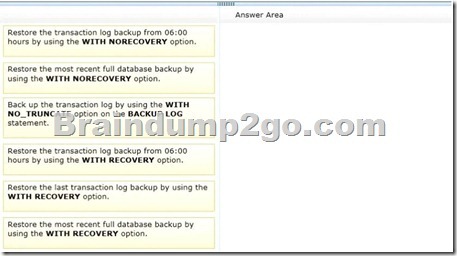
Answer:

QUESTION 173
You maintain multiple SQL Server 2008 instances.
You develop a failure recovery strategy.
You need to find out the edition and the build of SQL Server that is deployed in your environment.
What should you use to find the required information?
A. SELECT @@VERSION
B. SELECT * FROM sys.dm_os_sys_info
C. DBCC HELP
D. EXEC xp_msver
Answer: A
QUESTION 174
You administer a Microsoft SQL Server 2008 instance that contains two databases named Work and WorkHistory.
Work uses the Latin1_General_CS_AS collation.
WorkHistory uses the Latin1_General_100_CI_AI collation.
Each database has an Orders table that has the following definition:
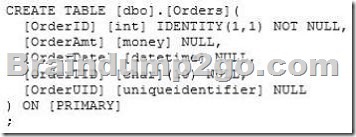
You need to return records from WorkHistory.dbo.Orders that exist in Work.dbo.Orders.
Which Transact-SQL query should you use?
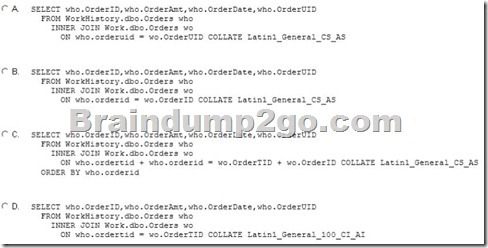
A. Option A
B. Option B
C. Option C
D. Option D
Answer: B
QUESTION 175
You administer a Microsoft SQL Server 2008 R2 instance.
Mirroring has been configured between two servers.
You need to ensure that automatic failover will occur when the principal server fails
What should you do?
A. Create a witness server to monitor the mirroring session. On the principal server, use the
ALTER DATABASE statement along with the SET WITNESS clause.
B. Create a witness server to monitor the mirroring session. On both partner servers, use the
ALTER DATABASE statement along with the SET WITNESS clause.
C. Create a Microsoft SQL Server Integration Services package on the partner server to monitor
the principal server.
D. Implement Policy Based Management. Enable the Server Performance management facet.
Answer: A
QUESTION 176
Drag and Drop Question
You administer a Microsoft SQL Server 2008 R2 database instance.
You plan to automate maintenance tasks.
What task types are included in a SQL Maintenance Plan? (To answer, drag the component to the correct task or tasks in the answer area. The component may be used once or more than once. Each task may be used once or not at all. Additionally, you may need to drag the split bar between panes or scroll to view content.)
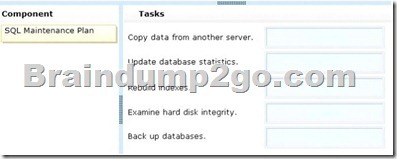
Answer:
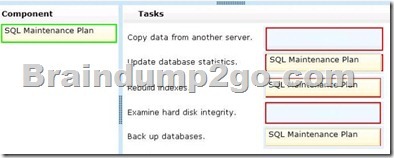
QUESTION 177
You maintain a SQL Server 2008 instance.
You discover that the database named CityPowerLightDB presents data integrity problems.
You perform a full database backup at 22:00 hours.
The SQL Server instance experiences a power failure at 05:59 hours.
No data modifications have occurred after the backup.
When the database is online, you discover that some table data pages are corrupt.
You need to completely repair the database in the minimum amount of time.
What should you do?
A. Restore the corrupt pages from the full database backup.
B. Restore the database from the full database backup.
C. Use the DBCC CHECKTABLE command along with the PHYSICAL_ONLY option.
D. Use the DBCC CHECKDB command along with the REPAIR_ALLOW_DATA_LOSS option.
Answer: A
QUESTION 178
You administer a Microsoft SQL Server 2008 R2 database that contains an OrderItems table.
The table has the following definition:
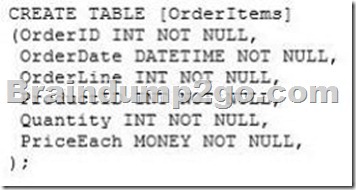
Currently, the table is partitioned by year with each year in its own filegroup.
You need to add a new partition for the upcoming year.
What should you do?
A. Remove the clustered index from the table.
B. Use the ALTER PARTITION FUNCTION … SPLIT RANGE statement.
C. Use the ALTER TABLEstatement to remove the COLLATEoption.
D. Execute the DBCC CLEANTABLEcommand on the OrderItems table.
E. Create a new filegroup.
Create a new database file.
Use the ALTER PARTITION SCHEME statement along with the NEXT USED clause.
Use ALTER INDEX REORGANIZE statement.
F. Create a new Filegroup.
Create a new database File.
Use the ALTER PARTITION SCHEME statement along with the NEXT USED clause.
Use the ALTER PARTITION FUNCTION statement along with the SPLIT RANGE clause.
G. Create a new table.
Use the ALTER TABLE statement along with the SWITCH PARTITION clause.
Use the ALTER PARTITION FUNCTION statement along with the MERGE RANGE clause.
H. Create a new partition function.
Create a new partition scheme.
Add a clustered index to place the data onto the partition scheme.
I. Run the following statement:
CREATE PARTITION SCHEME SEC_FG
AS PARTITION FUNC_FG
ALL TO (SECONDARY);
J. Run the following statement:
EXECUTE sp_tableoption
@TableNamePattern =’OrderItem3′,
@OptionName= `PartltionByYear’;
@OptionValue= ‘true’;
Answer: F
QUESTION 179
You administer a Microsoft SQL Server 2008 R2 database that contains an OrderItems table.
The table has the following definition:
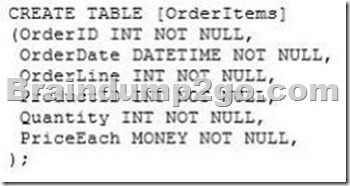
The following DDL has been run on the database:
CREATE PARTITION FUNCTION FUNC_FG (INT)
AS RANGE LEFT FOR VALUES (1, 100, 1000);
You need to create a partition scheme that will place all data to the SECONDARY filegroup.
What should you do?
A. Remove the clustered index from the table.
B. Use the ALTER PARTITION FUNCTION … SPLIT RANGE statement.
C. Use the ALTER TABLEstatement to remove the COLLATEoption.
D. Execute the DBCC CLEANTABLEcommand on the OrderItems table.
E. Create a new filegroup.
Create a new database file.
Use the ALTER PARTITION SCHEME statement along with the NEXT USED clause.
Use ALTER INDEX REORGANIZE statement.
F. Create a new Filegroup.
Create a new database File.
Use the ALTER PARTITION SCHEME statement along with the NEXT USED clause.
Use the ALTER PARTITION FUNCTION statement along with the SPLIT RANGE clause.
G. Create a new table.
Use the ALTER TABLE statement along with the SWITCH PARTITION clause.
Use the ALTER PARTITION FUNCTION statement along with the MERGE RANGE clause.
H. Create a new partition function.
Create a new partition scheme.
Add a clustered index to place the data onto the partition scheme.
I. Run the following statement:
CREATE PARTITION SCHEME SEC_FG
AS PARTITION FUNC_FG
ALL TO (SECONDARY);
J. Run the following statement:
EXECUTE sp_tableoption
@TableNamePattern =’OrderItem3′,
@OptionName= `PartltionByYear’;
@OptionValue= ‘true’;
Answer: I
QUESTION 180
You administer a Microsoft SQL Server 2008 R2 database that contains an OrderItems table.
The table has the following definition:
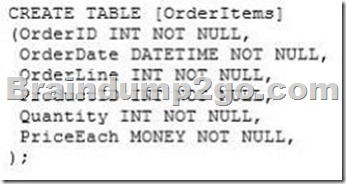
Currently, the table is partitioned by year with each year in its own filegroup.
You need to move the data from the oldest year into a new table in a different Schema to archive the data.
What should you do?
A. Remove the clustered index from the table.
B. Use the ALTER PARTITION FUNCTION … SPLIT RANGE statement.
C. Use the ALTER TABLEstatement to remove the COLLATEoption.
D. Execute the DBCC CLEANTABLEcommand on the OrderItems table.
E. Create a new filegroup.
Create a new database file.
Use the ALTER PARTITION SCHEME statement along with the NEXT USED clause.
Use ALTER INDEX REORGANIZE statement.
F. Create a new Filegroup.
Create a new database File.
Use the ALTER PARTITION SCHEME statement along with the NEXT USED clause.
Use the ALTER PARTITION FUNCTION statement along with the SPLIT RANGE clause.
G. Create a new table.
Use the ALTER TABLE statement along with the SWITCH PARTITION clause.
Use the ALTER PARTITION FUNCTION statement along with the MERGE RANGE clause.
H. Create a new partition function.
Create a new partition scheme.
Add a clustered index to place the data onto the partition scheme.
I. Run the following statement:
CREATE PARTITION SCHEME SEC_FG
AS PARTITION FUNC_FG
ALL TO (SECONDARY);
J. Run the following statement:
EXECUTE sp_tableoption
@TableNamePattern =’OrderItem3′,
@OptionName= `PartltionByYear’;
@OptionValue= ‘true’;
Answer: G
Braindump2go Promises All our customers: 100% All Exams Pass Or Full Money Back! Our experts have complied the fail proof 70-432 Exam content to help all candidates pass your 70-432 certification exam easily in the first attempt and score the top possible grades too.Do you want to sucess? Come to Braindump2go and our experts team will tell you what you need to do! 70-432 Exam Dumps Full Version Download:






